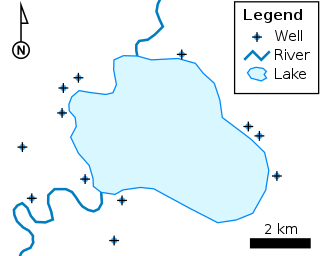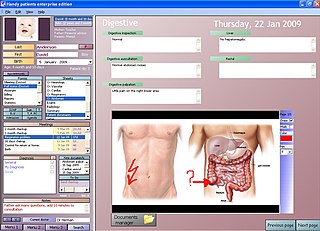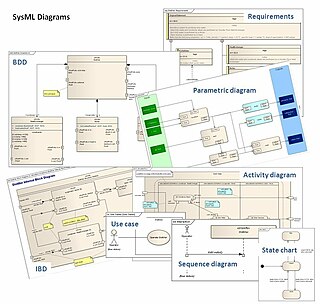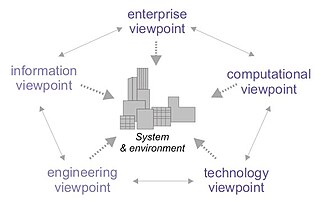Related Research Articles
Adl is an Arabic word meaning justice.

The Geography Markup Language (GML) is the XML grammar defined by the Open Geospatial Consortium (OGC) to express geographical features. GML serves as a modeling language for geographic systems as well as an open interchange format for geographic transactions on the Internet. Key to GML's utility is its ability to integrate all forms of geographic information, including not only conventional "vector" or discrete objects, but coverages and sensor data.
Health Level Seven, abbreviated to HL7, is a range of global standards for the transfer of clinical and administrative health data between applications with the aim to improve patient outcomes and health system performance. The HL7 standards focus on the application layer, which is "layer 7" in the Open Systems Interconnection model. The standards are produced by Health Level Seven International, an international standards organization, and are adopted by other standards issuing bodies such as American National Standards Institute and International Organization for Standardization. There are a range of primary standards that are commonly used across the industry, as well as secondary standards which are less frequently adopted.

An electronic health record (EHR) also known as an electronic medical record (EMR) or personal health record (PHR) is the systematized collection of patient and population electronically stored health information in a digital format. These records can be shared across different health care settings. Records are shared through network-connected, enterprise-wide information systems or other information networks and exchanges. EHRs may include a range of data, including demographics, medical history, medication and allergies, immunization status, laboratory test results, radiology images, vital signs, personal statistics like age and weight, and billing information.
openEHR is an open standard specification in health informatics that describes the management and storage, retrieval and exchange of health data in electronic health records (EHRs). In openEHR, all health data for a person is stored in a "one lifetime", vendor-independent, person-centred EHR. The openEHR specifications include an EHR Extract specification but are otherwise not primarily concerned with the exchange of data between EHR-systems as this is the focus of other standards such as EN 13606 and HL7.
Classification Markup Language (ClaML) is an XML data format specification meant for the exchange of medical classifications, which are code numbers for of medical diagnoses and procedures.

The systems modeling language (SysML) is a general-purpose modeling language for systems engineering applications. It supports the specification, analysis, design, verification and validation of a broad range of systems and systems-of-systems.

Reference Model of Open Distributed Processing (RM-ODP) is a reference model in computer science, which provides a co-ordinating framework for the standardization of open distributed processing (ODP). It supports distribution, interworking, platform and technology independence, and portability, together with an enterprise architecture framework for the specification of ODP systems.

The European Institute for Health Records or EuroRec Institute is a non-profit organization founded in 2002 as part of the ProRec initiative. On 13 May 2003, the institute was established as a non-profit organization under French law. Current President of EuroRec is Prof. Dipak Kalra. The institute is involved in the promotion of high quality Electronic Health Record systems in the European Union. One of the main missions of the institute is to support, as the European authorised certification body, EHRs certification development, testing and assessment by defining functional and other criteria.
The European Committee for Standardization (CEN) Standard Architecture for Healthcare Information Systems, Health Informatics Service Architecture or HISA is a standard that provides guidance on the development of modular open information technology (IT) systems in the healthcare sector. Broadly, architecture standards outline frameworks which can be used in the development of consistent, coherent applications, databases and workstations. This is done through the definition of hardware and software construction requirements and outlining of protocols for communications. The HISA standard provides a formal standard for a service-oriented architecture (SOA), specific for the requirements of health services, based on the principles of Open Distributed Processing. The HISA standard evolved from previous work on healthcare information systems architecture commenced by Reseau d’Information et de Communication Hospitalier Europeen (RICHE) in 1989, and subsequently built upon by a number of organizations across Europe.
The Health informatics - Electronic Health Record Communication was the European Standard for an information architecture to communicate patients' electronic health records (EHRs). The standard was later adopted as ISO 13606 and later replaced with ISO 13606-2 and recently ISO 13606-5:2010.
CEN/TC 251 is a technical decision making body within the European Committee for Standardization (CEN) working on standardization in the field of Health Information and Communications Technology (ICT) in the European Union. The goal is to achieve compatibility and interoperability between independent systems and to enable modularity in Electronic Health Record systems.
The system of concepts to support continuity of care, often referred to as ContSys, is an ISO and CEN standard . Continuity of care is an organisational principle that represents an important aspect of quality and safety in health care. Semantic interoperability is a basic requirement for continuity of care. Concepts that are needed for these purposes must represent both the content and context of the health care services.
Health Level Seven International (HL7) is a non-profit ANSI-accredited standards development organization that develops standards that provide for global health data interoperability.

Sparx Systems Enterprise Architect is a visual modeling and design tool based on the OMG UML. The platform supports: the design and construction of software systems; modeling business processes; and modeling industry based domains. It is used by businesses and organizations to not only model the architecture of their systems, but to process the implementation of these models across the full application development life-cycle.

Dipak Kalra is President of the European Institute for Health Records and of the European Institute for Innovation through Health Data. He undertakes international research and standards development, and advises on adoption strategies, relating to Electronic Health Records.
Clinical data standards are used to store and communicate information related to healthcare so that its meaning is unambiguous. They are used in clinical practice, in activity analysis and finding, and in research and development.
References
- ↑ S. Heard & T. Beale. (eds.) (2005). "Archetype definitions and principles" (PDF). openEHR. Retrieved 22 May 2013.
{{cite web}}:|author=has generic name (help) - ↑ "ISO 13606-2:2008 Health informatics -- Electronic health record communication -- Part 2: Archetype interchange specification". ISO TC 215. Retrieved 23 May 2016.
- ↑ "ISO 13606-2:2019 Health informatics — Electronic health record communication — Part 2: Archetype interchange specification". ISO TC 215. Retrieved 30 Nov 2019.
- ↑ "Archetype Modeling Language™ (AML™)". Object Management Group.
- ↑ "LinkEHR". Veratech for Health. Retrieved 24 Aug 2023.
- ↑ pygments/tests/examplefiles/adl/test_basic.adls on GitHub
openEHR documents
- ↑ "openEHR website". openEHR Foundation.
- ↑ "openEHR Archetype specifications". openEHR.org. openEHR Foundation. Retrieved 30 Nov 2019.
- ↑ "Archetype Technology Overview". openEHR.org. openEHR Foundation. Retrieved 30 Nov 2019.
- ↑ "Archetype Definition Language 1.4 specification". openEHR Foundation. Retrieved 23 May 2016.
- ↑ "Archetype Object Model (AOM) 1.4". openEHR Foundation. Retrieved 23 May 2016.
- ↑ "Archetype Object Model 2 (AOM2) Specification". openEHR Foundation. Retrieved 30 Nov 2019.
- ↑ "Archetype modelling tools". openEHR Foundation. Retrieved 23 May 2016.
- ↑ "ADL Designer". openEHR ADL Designer team.